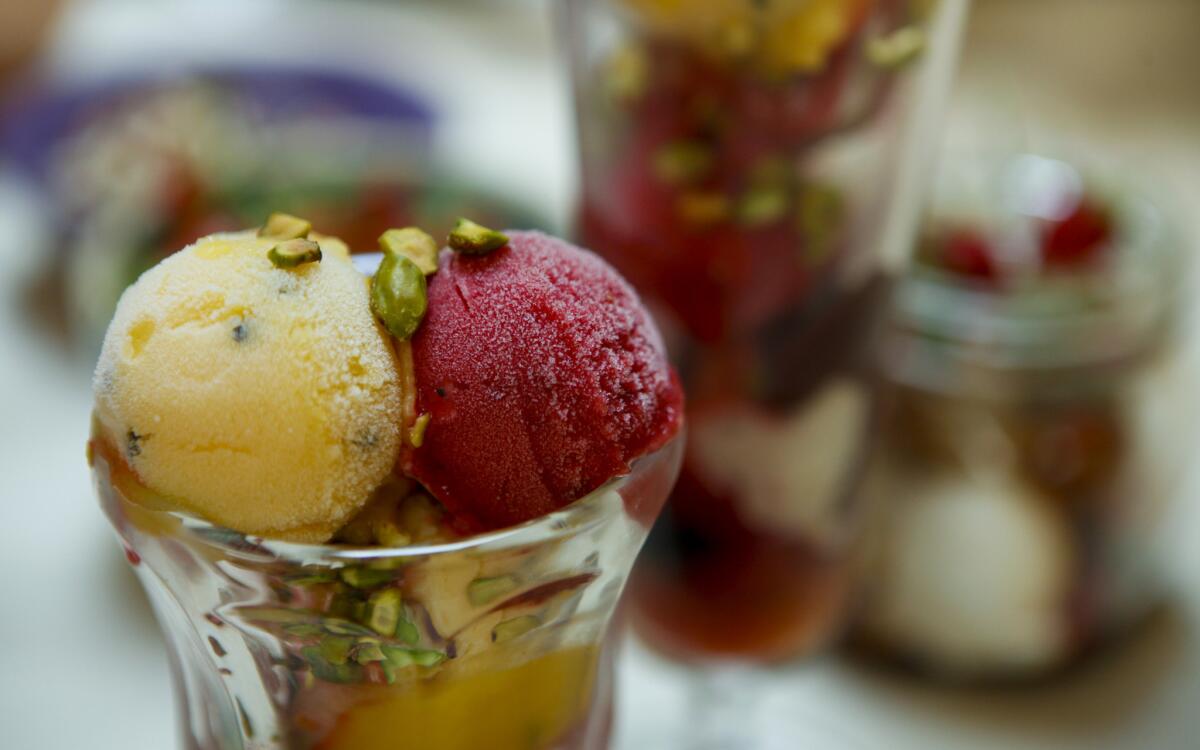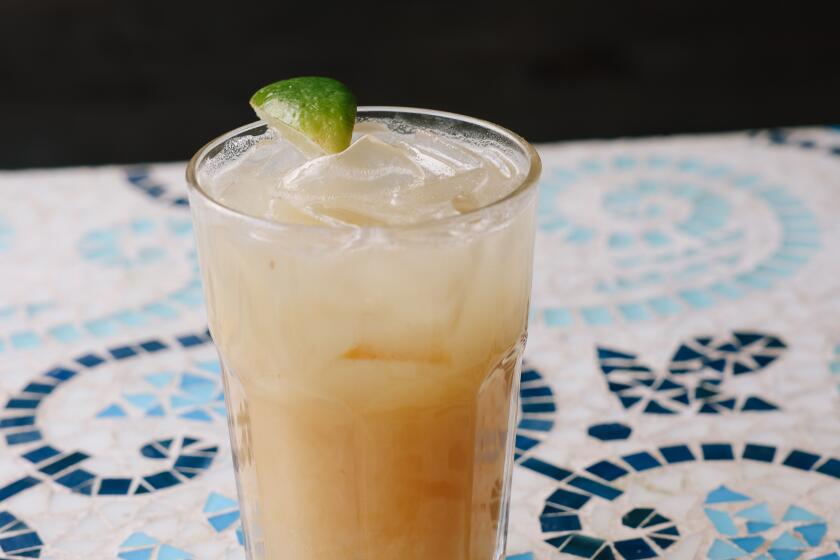Mango and passion fruit sorbet

- Share via
Amelia Saltsman spends a lot more time at farmers markets than you do. Unless you’re a farmer, at any rate, in which case you probably know Saltsman and have maybe talked to her for her first book, “The Santa Monica Farmers Market Cookbook,” which you can still find at Anthropologie stores. Saltsman has been cooking and writing about cooking for decades and has finally published her long-awaited second cookbook, “The Seasonal Jewish Kitchen.” Think more farmers markets, but this time Saltsman is channeling her childhood (her family is Romanian-Iraqi-Israeli), and in her new book she cooks her way through the Jewish calendar. To quote Deborah Madison, another market junkie who wrote the book’s foreword: “This is Jewish food? Who knew?”
Recently we met up with Saltsman at her Santa Monica home to chat and to make ice cream sundaes for lunch. Because wouldn’t you? Also because these Brooklyn Bar Ice Cream sundaes are just the thing for summertime in L.A., as much as they were for Saltsman herself when she first ate them as a little kid at the popular cafe in Tel Aviv. Check out the recipes, then go to the farmers market (of course) and make ice creams and sorbets with local fruit. Make sauces. Layer sundaes like building blocks. Eat them for lunch too.
Your parents met in the Israeli army?
My father was a captain and my mother was sergeant. My father would come into the office that my mother was working in — even though women were weapons-trained, they worked in offices back then.
Why write about Jewish food?
I wanted to use [the book] to give traditional context to our modern seasonal lives — and I wanted to make it feel universal. This was the next step on the journey — more personal, more biblical. We’ve been talking about knowing where our food comes from; I’ve been looking at that through time. With this particular lens, I was also looking at the journey of ingredients. Like the citron. How did it travel? Who was carrying it? The citron wasn’t a fruit in the Bible. It’s a scrubby old thing, not a sturdy tree. But it was considered a perfect fruit — because of the aroma. Then it became a symbol carried by the Hebrews as they migrated. Think of it as an agricultural diaspora as well as the diaspora of the Jews.
So many dishes (yours, everyone’s) are about building blocks. How do you decide how to put them together?
I think of it in terms of flavor and texture and color contrasts. And what the foods bring to each other — I like to flavor food with other foods. There aren’t a lot of bottles here on the counter. This is what the farmers give their lives to. You want to respect the ingredients and not mask them — and that’s a real shift in how we cook. The essence of seasonal market-based cooking is not to mess with what the farmers have already done.
Three tips for shopping at farmers markets?
One, shop (and eat) in “layers” to get the longest-lasting reward. Buy a mix of shelf-stable, medium-hold and perishable items, and use the most perishable items first. With items like tomatoes or stone fruit, buy a range of moderately ripe to dead-ripe, so you can pace your enjoyment throughout the week. Two, focus on whatever is at the peak of its season. Try to resist the urge to splurge on first-of-the-season appearances; a little patience rewards us with the greatest flavor. Three, engage all your senses, including common sense. Trust your inner smarts and you’ll be fine. It’s just food. But oh, what food.
How much has changed in the food scene since you started writing about it?
It depends on what we’re talking about. If we’re talking about Los Angeles, if you go back to the Los Angeles Times archives from the 19th century, you’ll find discussions about farmers markets and who’s selling and who’s honest and the people peddling the best fruit. L.A. County was the biggest growing county in the state for a long time — famous for its Cahuenga apricots and all these little microclimates. We just had to come back to it. It’s a cycle. “There’s nothing new under the sun.” (That’s Ecclesiastes.)
Stand a mango, stem end down, on a cutting board and use a serrated knife to cut from the top to the bottom, running the blade close to the pit. Turn the mango around and repeat on the opposite side. Use a spoon to scoop the flesh from the skin and transfer it to the jar of a blender. Cut away any usable flesh attached to the pit, peel it and add to the jar. Squeeze the pit over the jar to extract the juices from any flesh clinging to the pit. Repeat with the second mango.
Stir the sugar, lime juice, water and salt in the blender and purée until smooth. Taste the purée, and if it is fibrous, strain it through a sieve into a bowl.
To prepare the passion fruit, halve the fruit and scoop the pulp and seeds into a small bowl. Mash the pulp with a fork to liquefy, then stir the pulp and seeds into the mango mixture. (If using purée, stir directly into the mango mixture.) Cover and chill the mixture several hours, up to overnight.
Make the sorbet: Freeze the mixture in an ice cream maker according to the manufacturer’s instructions. Pack into a chilled container, cover tightly and freeze, preferably for several hours, before serving. Remove from the freezer about 10 minutes before serving to make the scooping easier.
Get our Cooking newsletter.
Your roundup of inspiring recipes and kitchen tricks.
You may occasionally receive promotional content from the Los Angeles Times.
















